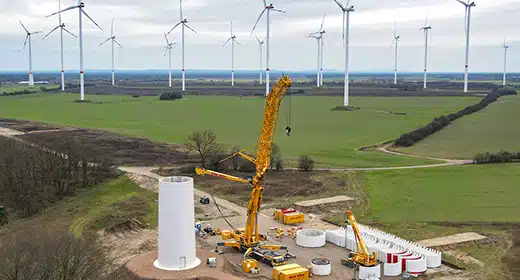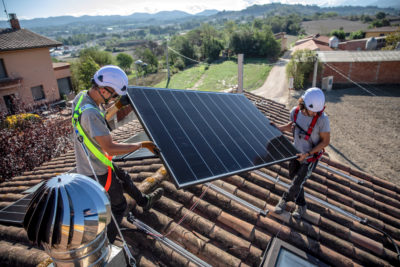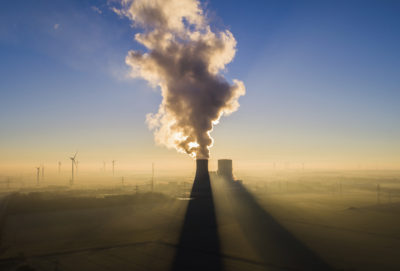by Paul Hockenos: Faced with the cutoff of Russian gas and oil, Europe ramped up solar and wind power,
 got serious about energy conservation, and tweaked policies to speed its green transition. Despite fears of increased emissions this winter, the EU remained on track to meet its climate goals.
got serious about energy conservation, and tweaked policies to speed its green transition. Despite fears of increased emissions this winter, the EU remained on track to meet its climate goals.
When a cold snap hit northern Europe last November, ordinary citizens and industry leaders alike feared the onset of an agonizing winter of deprivation, spiraling energy prices, unheated buildings, and work stoppages. After all, embargoes in place as a result of Russia’s invasion of Ukraine had severely curtailed oil and gas deliveries to many countries and upended supply chains that much of Europe had come to rely on.
Germany — whose industrial economy depended heavily on Russian fuel — scurried to revive its mothballed coal-fired power plants, construct liquefied natural gas terminals, and secure new gas supplies from across the world. Painful though it was to European environmentalists, efforts to slash emissions took a back seat to making it through the winter by any means necessary.
But defying the grimmest of projections, Europe made it through the temperate winter with remarkably few casualties — and even with a few big wins to its credit. The effort may have displaced Europe’s climate aspirations by a fraction, with 17 of Europe’s resuscitated coal plants belching out 16 million tons of carbon dioxide in 2022. But thanks to a record rollout of renewable energy sources combined with conservation measures, the continent’s emissions footprint actually positioned the EU to remain within reach of its goal to slash emissions by at least 55 percent in seven years’ time. In a year when planetary emissions edged upward, Europe is now on track to comfortably outpace its pledge to generate 40 percent of its total energy from renewable sources by 2030.
In 2022, Europe saw wind and solar power overtake nuclear power and natural gas for the first time.
“We did it!,” proclaimed Germany’s daily, Süddeutsche Zeitung, in late February. “No freezing, no unrest, no mass bankruptcy. Russia’s weaponizing of gas has been disabled. Germany and Europe have bought themselves valuable time.”
“We were damn lucky,” says Karsten Neuhoff of DIW Berlin, an economic research institute, qualifying the newspaper’s bravado by pointing to the unseasonably warm winter, China’s ebb in gas demand, which freed up resources for Europe and kept prices lower, and the restarting of some of France’s nuclear reactors, which had been offline for maintenance or repairs, in January of this year.
In terms of climate protection, Lauri Myllyvirta of the Centre for Research on Energy and Clean Air, an independent Finnish research organization, says that Europe, despite all the hardships caused by the war in Ukraine, took a giant stride in 2022 — the result of extraordinarily high fossil fuel prices, which spurred energy conservation, faster-than-ever deployment of clean tech, and ramped up EU policies. “This portends Europe’s nearly complete phaseout of coal and a substantial reduction in natural gas generation in the power sector by 2030,” says Myllyvirta. “We’re moving in that direction now.”
The secret to Europe’s success was its expansive deployment of solar photovoltaics and wind farms, which had a combined generation that jumped by 15 percent in 2022 over the previous year, offsetting the deleterious burning of coal and together overtaking, for the first time, electricity generated by both gas and nuclear power.
Workers install a solar panel on a home in Barcelona, Spain, last September. ANGEL GARCIA / BLOOMBERG VIA GETTY IMAGES
Wind power, the presumptive backbone of Europe’s future electric supply, provided the biggest boost. Onshore and offshore wind farms met 17 percent of European Union and United Kingdom power demand in 2022, roughly equivalent to the generation of 255 medium-sized nuclear reactors. Led by the continent’s wind energy powerhouses — Germany, Sweden, Finland, and France — Europe installed more new wind capacity than ever before.
Still, the pace of wind turbine rollouts was slower than that envisioned by the European Green Deal, the EU’s 2020 roadmap for carbon neutrality by 2050. Experts blamed the prodigious red tape that European developers must wade through.
“The whole process — the planning, permitting, and financing — has to get simpler,” says DIW Berlin’s Neuhoff, noting that the German government is now working on this. A law that went into effect this year stipulates that a minimum of two percent of Germany’s land mass be set aside for onshore wind energy. German Chancellor Olaf Scholz predicted that this law, together with others that simplify wind farm development, would add “four to five wind turbines per day” until 2030.
“People seemed to understand that they have to save gas to prevent the crisis from escalating — and they did.”
In contrast to the new wind farms, the expansion of clean tech that can be quickly deployed by citizens and businesses — rooftop solar, electric vehicles, and residential heat pumps — shattered records and emptied warehouses. “Solar panels can be bought online, e-cars at a local car dealership,” says Myllyvirta. Such investments helped increase solar generation across the EU by 24 percent, according to the global energy think tank Ember. Installing heat pumps is more involved, Myllyvirta notes, but sales of this equipment in 2022 jumped almost 38 percent over 2021.
Limited supplies and shortages of skilled labor, not demand, kept all three technologies from growing even more, he notes. “But the demand signals are pushing suppliers to scale up as fast as possible.”
The surge in clean-energy technologies not only filled in for the missing Russian gas, it also helped offset the loss of about 32 percent of the nuclear and hydropower generated last year, a trend that raises questions about the reliability of these energy sources in the future — in Europe and beyond. The fall in nuclear power resulted largely from France’s chronically ailing fleet, while hydropower suffered from exceptionally dry summer conditions that repeated this past January.
Europe profited immensely from the determined efforts of its citizens and its private sector to reduce energy use. Households turned down thermostats, switched off nonessential lighting, took shorter showers, donned heavier sweaters and wool socks, vacationed closer to home, and insulated windows and doors, among other energy efficiency measures.
To conserve energy, this restaurant in Alessandria, Italy, turned off its lights and set out candles. DIANA BAGNOLI / GETTY IMAGES
In Germany, no one was certain whether people would cooperate of their own volition. But research has shown that in combination with a relatively mild winter, conservation efforts by individuals, businesses, and even factories reduced overall gas consumption by 15 percent. Individual motivations varied: many saw no alternative in the face of soaring energy bills and inflated consumer prices; others framed their sacrifice in terms of solidarity with the people of Ukraine or as a boon to climate protection. Whatever the reason, Europeans embarked on the energy-saving actions that efficiency experts have long advocated — and hope to make permanent.
“There was a positive attitude about conserving energy,” says Neuhoff. “People seemed to understand that they have to save gas to prevent the crisis from escalating — and they did.” And, emphasizes Neuhoff, “Industry cut back even more than ordinary people.” Citing high energy prices and the scaling back of some production, the industrial sector slashed gas use by around 25 percent.
Governments lent a helping hand, approving emergency heating-cost subsidies and passing energy-savings ordinances. In Germany, for example, retail stores were required to keep their doors shut during the day to conserve heat and to turn off nighttime advertising lights to reduce electricity consumption. In Denmark, Christmas lighting was reduced; Finns were encouraged to spend fewer hours in the sauna; and France banned the use of hot water in public buildings.
The EU, an institution that rarely squanders the opportunity to capitalize on a crisis, set into motion an ambitious updating of the Green Deal that would rapidly reduce dependence on Russian fossil fuels by 2027 and fast forward its green transition. Later this month, the EU is expected to ratchet up its renewable energy target from 40 to 45 percent of total production, push forward binding efficiency measures, and commit to spending an additional 210 billion euros on new energy infrastructure.
The mothballed Mehrum coal-fired power plant in Hohenhameln, Germany was brought back online last August to help curb the use of natural gas. JULIAN STRATENSCHULTE / PICTURE-ALLIANCE/ DPA / AP IMAGES
For its part, the German government is currently discussing a controversial ban on almost all new oil and gas heating systems as of 2024. Proposed by the Green Party, the draft law calls for switching from natural gas and oil-burning systems to heat pumps, the burning of biomass, and district heating that relies on renewables and waste heat.
Despite the welcome news, Europe must still reach higher to recalibrate life without Russian fossil fuels and hit its climate goals. The longer-term projects, like retrofitting all of Europe’s housing stock for energy efficiency, lag woefully behind. According to Neuhoff, Germany should gradually up the pace of the energy-efficient refurbishing of old buildings from 1 percent a year to 4 percent a year. Heating and cooling currently accounts for about half of the energy consumed by European homes and businesses, more than a third of its greenhouse gas emissions, and 35 percent of the EU’s gas consumption, according to DIW Berlin.
The International Energy Agency warns that next winter, the EU could face a potential shortfall of almost 30 billion cubic meters of natural gas if Chinese demand rebounds and temperatures plummet. The EU itself estimates that it must nearly double its renewable power generation by 2030 just to hit its own emissions targets. Unless Europe pushes even further — in clean energy expansion, smart grid rollout, adoption of electric vehicles, building retrofits, and increasing energy storage capacity — it might find itself feeling wistful about the comfortable winter of 2022-23.










































